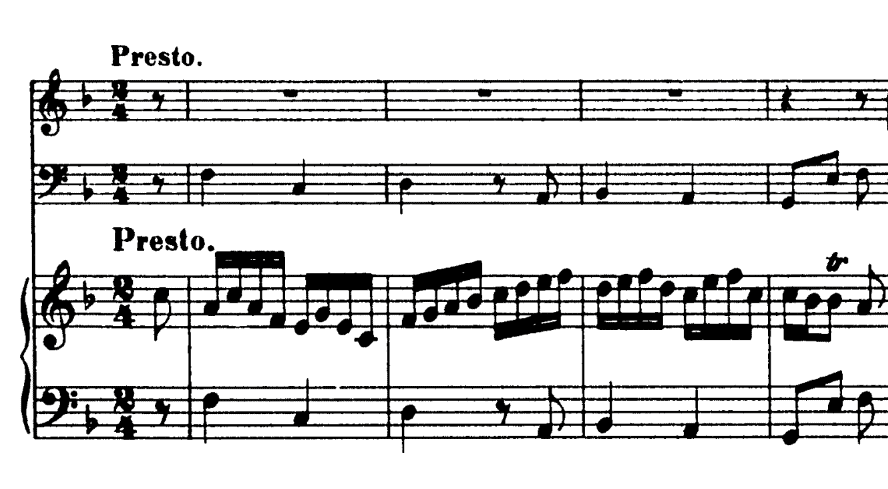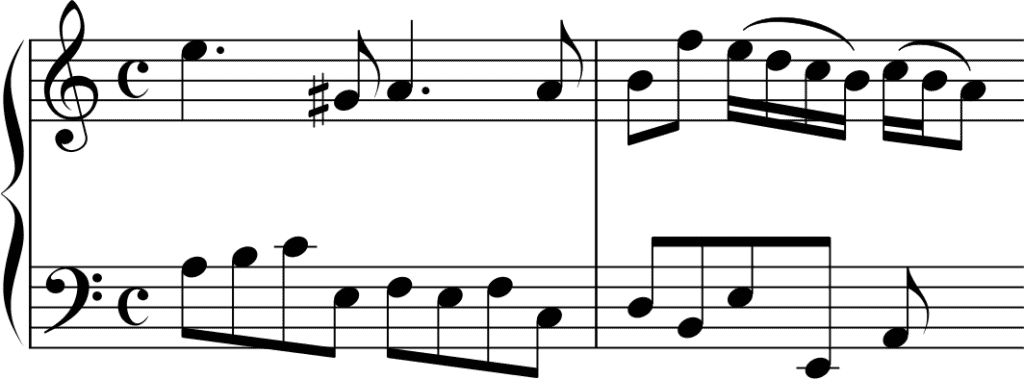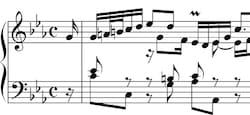In this essay, I will deal with a schema that is a variant of the Leaping Romanesca (or Pachelbel Pattern or Pachelbel sequence), characterized by its modified and shortened end. For more information on the (regular) Leaping Romanesca see my essay The Leaping Romanesca (The Pachelbel Pattern): The Basics.
The Leaping Romanesca with a modified and shortened end is a pattern that starts as a regular Leaping Romanesca but breaks off after 2 segments. Moreover, stage 4 is not set as a triad but as a sixth chord and stage 5 often coincides with the start of a cadential progression or of a Prinner.
This essay will include not only a theoretical explanation but also repertoire examples.
Recap: What Is a (Regular) Leaping Romanesca?
Below you find the Leaping Romanesca as exemplified by bars 5–6a of the Canon in D major written by the German composer, organist and pedagogue Johann Pachelbel (1653–1706). For more information, see my essay The Leaping Romanesca (The Pachelbel Pattern): The Basics.

The Leaping Romanesca with a Modified and Shortened End in Major
The example above illustrates that the (regular) Leaping Romanesca is a descending sequence consisting of three segments. As for the Romancesca with a modified and shortened end, however, it breaks off after two segments, leading into a cadence:

In addition, the realization of stage 4 is different. Instead of harmonizing it as a triad, it is set as a sixth chord. One might argue that this modification is due to the so-called Mi-Fa rule, which was considered fundamental in the eighteenth century and states that, when the bass rises a minor second, a sixth chord should be played on the first bass note (Mi) and a triad on the second (Fa). This rule took precedence over the regularity of the Romanesca in the eighteenth century, which meant that instead of an ‘old-fashioned’ triad, a sixth chord was played on ③. This sixth chord often introduces a cadence rather than respecting the sequence in the third segment.
In his groundbreaking book Music in the Galant Style from 2007, Robert O. Gjerdingen mentions this type of Romanesca (New York: Oxford University Press, 2007, p. 26).
Johann Schobert (ca. 1735–1767) uses this pattern to open the fourth movement of his Trio for harpsichord, violin and bass in F major opus 16/4, to give just one example of the schema in major. (Schobert was a Silesian harpsichordist and composer who ended his career successfully in Paris.)

Note how the Leaping Romanesca with a modified and shortened end is followed here by a schema that Gjerdingen has baptized the Prinner. The (two-part) Prinner is characterized by
- a bass that descends in stepwise motion from ④ to ① (in this case, ⑦ is inserted in between ② and ①, making its conclusion into a mild clausula cantizans or ⑦–① cadence)
- an upper voice that descends in stepwise motion from ➏ to ➌ in parallel thirds with the bass.
I will explore the Prinner at length in a series of yet-to-be-published essays.
The Leaping Romanesca with a Modified and Shortened End in Minor
The Romanesca with a modified and shortened end also occurs in minor:

The reason for setting stage 4 as a sixth chord instead of a triad is obviously not because of the Mi-Fa rule in this case. After all, the interval from ③ to ④ is not a semitone but a whole tone. Rather, the triad on ③ in a minor key (with a lowered ➐) was considered less suitable in the eighteenth century to introduce a cadence. Unlike the Romanesca with a modified and shortened end in major, the deceptive cadence in the minor version requires the leading note to rise in order to avoid a melodic augmented second.
I have included two repertoire examples of the Romanesca with a modified and shortened end in minor. The first one is the opening of the allemande from J.S. Bach’s second French suite in C minor BWV813. The second one shows the start of the adagio from the sixth sonata for oboe and basso continuo in A minor by Domenico Maria Dreyer (?–?). (Very little is known about Dreyer. In the years 1731–1734, he was working at the St Petersburg court, but we do not know in what capacity. He was the brother of the well-known castrato, chapel master and composer Giovanni Filippo Dreyer (ca. 1703–1772).) In both cases, the Romanesca with a modified and shortened end is followed by a cadential progression.


Further Reading (Selection)
Primary Sources
Fenaroli, Fedele. METODO PER BENE ACCOMPAGNARE LIBRO 1, Partimenti, Critical edition, ed. Ewald Demeyere (Ottignies, 2021).
Fenaroli, Fedele. METODO PER BENE ACCOMPAGNARE LIBRO 1, Critical Comments, Critical edition, ed. Ewald Demeyere (Ottignies, 2021).
Fenaroli, Fedele. METODO PER BENE ACCOMPAGNARE LIBRO 2, Partimenti, Critical edition, ed. Ewald Demeyere (Ottignies, 2021).
Fenaroli, Fedele. METODO PER BENE ACCOMPAGNARE LIBRO 2, Critical Comments, Critical edition, ed. Ewald Demeyere (Ottignies, 2021).
Fenaroli, Fedele. METODO PER BENE ACCOMPAGNARE LIBRO 3, Partimenti, Critical edition, ed. Ewald Demeyere (Ottignies, 2021).
Fenaroli, Fedele. METODO PER BENE ACCOMPAGNARE LIBRO 3, Critical Comments, Critical edition, ed. Ewald Demeyere (Ottignies, 2021).
Fenaroli, Fedele. REGOLE MUSICALI PER I PRINCIPIANTI DI CEMBALO, A Comparative Edition (V1.0), compiled and edited by Ewald Demeyere (Ottignies, 2021).
Fenaroli, Fedele. The Parma Manuscript — Partimento Realizations of Fedele Fenaroli (1809), ed. Ewald Demeyere (Visby: Wessmans Musikförlag,2021).
Mattei, Stanisloa. Pratica d’Accompagnamento Sopra Bassi Numerati E Contrappunti A Più Voci (Bologna, 1824).
Paisiello, Giovanni. Regole Per bene accompagnare il Partimento (St. Petersburg, 1782).
Secondary Sources
Gjerdingen, Robert O. Music in the Galant Style (New York: Oxford University Press, 2007).
Gjerdingen, Robert O. Child Composers in the Old Conservatories — How Orphans Became Elite Musicians (New York: Oxford University Press, 2020).
IJzerman, Job. Harmony, Counterpoint, Partimento: A New Method Inspired by Old Masters (New York: Oxford University Press, 2018).
Paraschivescu, Nicoleta. Die Partimenti Giovanni Paisiellos — Wege zu einem praxisbezogenen Verständnis (Basel: Schwabe Verlag, 2018).
Paraschivescu, Nicoleta (Translator: Chris Walton). The Partimenti of Giovanni Paisiellos — Pedagogy and Practice (New York: University of Rochester Press, 2022).
Sanguinetti, Giorgio. The Art of Partimento — History, Theory, and Practice (New York: Oxford University Press, 2012).
